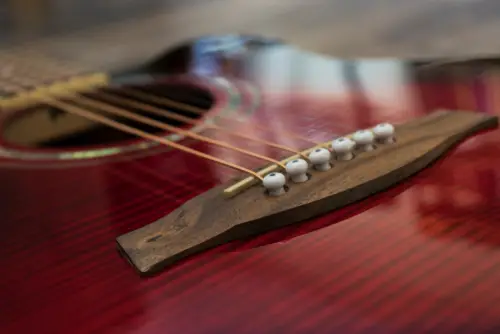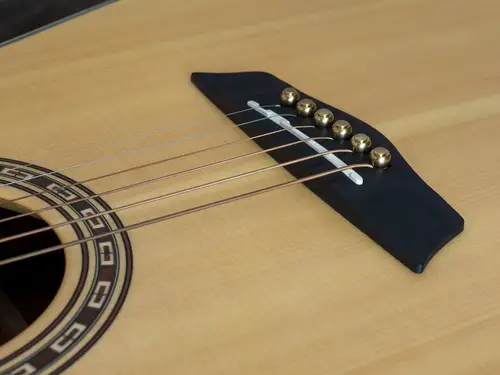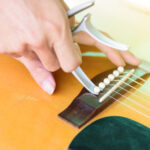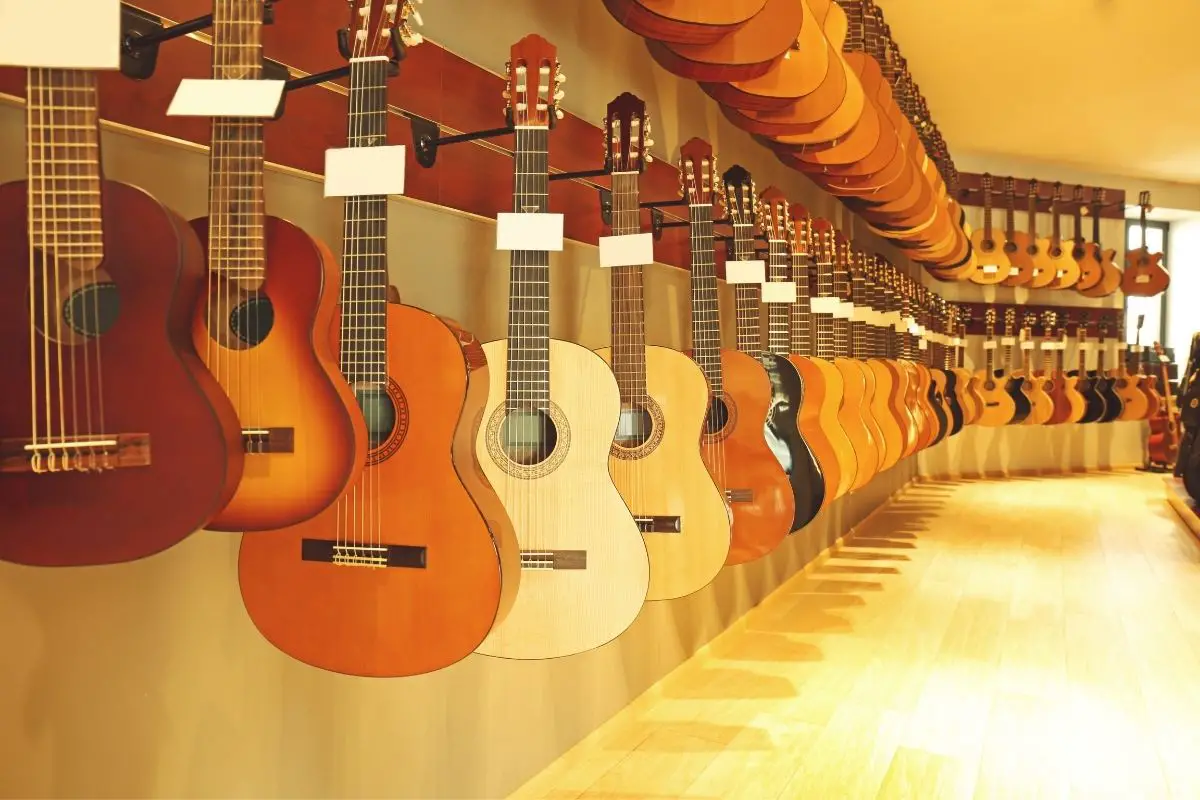Guitar players often experiment with various components of their instrument to achieve the desired sound and tone. One such component is the bridge pins that hold the strings in place at the bridge of the guitar.
The two most common materials used for bridge pins are bone and plastic. The question arises: are bone bridge pins better than plastic?
Bone and plastic bridge pins have their own unique characteristics that affect the sound, tone, and appearance of the guitar. Bone bridge pins are known for their durability and resonance, while plastic bridge pins are more affordable and come in a variety of colors.
However, the debate on which material is superior is ongoing, with some guitar players swearing by bone bridge pins and others preferring plastic.
Key Takeaways on Are Bone Bridge Pins Better Than Plastic
- Bone and plastic bridge pins have their own unique characteristics that affect the sound, tone, and appearance of the guitar.
- The debate on whether bone or plastic bridge pins are better is ongoing, with no clear winner.
- Ultimately, the choice between bone and plastic bridge pins comes down to personal preference and experimentation.
Check out these other popular posts :
- 5 Best Bridge Pins For Acoustic Guitar (Comparison & Reviews)
- Do Acoustic Guitar Bridge Pins Make a Difference?
- What is the Best Material for Acoustic Guitar Bridge Pins?
The Basics of Guitar Bridge Pins

Bridge pins are the small cylindrical pegs that hold the strings in place on the bridge of an acoustic guitar. They are typically made of plastic, bone, or other materials, and come in a variety of sizes and shapes. The choice of bridge pins can have an impact on the sound and playability of the guitar.
Functionally, bridge pins serve to anchor the strings to the bridge, ensuring that they stay in place and maintain proper tension. They also help to transfer the vibrations of the strings to the soundboard of the guitar, which is what produces the sound.
Plastic bridge pins are the most common type, and are often included as standard equipment on many guitars. They are relatively inexpensive, lightweight, and easy to replace. However, some players find that plastic bridge pins can produce a slightly duller or less resonant tone compared to other materials.
Bone bridge pins, on the other hand, are often touted as an upgrade over plastic. They are denser and heavier than plastic, which can help to transfer more energy from the strings to the guitar’s soundboard.
Some players also believe that bone bridge pins produce a clearer, more articulate tone with better sustain.
It’s worth noting that the impact of bridge pins on tone and playability can be subtle, and may be influenced by a variety of other factors, such as the type of strings, the guitar’s construction, and the player’s technique.
As with many aspects of guitar setup and maintenance, the choice of bridge pins is ultimately a matter of personal preference.
Material Comparison: Bone vs Plastic
When it comes to guitar bridge pins, two of the most popular materials are bone and plastic. Each material has its own set of advantages and disadvantages. This section will explore the differences between the two materials and help you decide which one is best for you.
Bone

Bone is a natural material that has been used in guitar making for centuries. It is known for its excellent tonal properties and durability. Bone bridge pins are denser than plastic ones, which can help improve sustain and clarity. Bone pins also have a unique look that many guitarists find appealing.
However, bone bridge pins can be more expensive than plastic ones. They also require more maintenance, as they can become discolored or brittle over time. Some guitarists also prefer not to use bone pins due to ethical concerns.
Plastic
Plastic bridge pins are a popular choice for guitarists due to their affordability and ease of maintenance. They come in a variety of colors and styles, making it easy to find a set that matches your guitar’s aesthetic. Plastic pins are also less likely to break or become discolored over time.
However, plastic bridge pins are less dense than bone ones, which can affect the guitar’s tone. They can also feel less substantial in the hand, which may be a concern for some guitarists.
Material
In terms of material, bone is a natural material while plastic is a synthetic one. Bone bridge pins are made from the shinbone of a cow, while plastic ones are made from materials such as ABS or nylon.
Density
As mentioned earlier, bone bridge pins are denser than plastic ones. This can affect the guitar’s tone, as denser materials tend to produce clearer and more sustained notes. However, the difference in density may not be noticeable to all guitarists.
Sound and Tone Differences

When it comes to the sound and tone of bone and plastic bridge pins, there are some differences that can be observed.
Bone bridge pins are known to produce a warmer and richer tone compared to plastic bridge pins. This is because bone is a denser material that can transfer vibrations more efficiently.
As a result, bone bridge pins can produce more overtones and harmonics, which can make the sound more complex and interesting.
In terms of sustain, bone bridge pins are also known to provide more sustain compared to plastic bridge pins. This is because bone is a harder material that can resist the string’s vibrations better, allowing the note to ring out longer.
When it comes to treble and bass, bone bridge pins are generally known to produce a more balanced sound compared to plastic bridge pins. Plastic bridge pins tend to emphasize the treble frequencies, while bone bridge pins can produce a more even distribution of treble and bass frequencies.
Overall, bone bridge pins can produce a brighter and more resonant sound compared to plastic bridge pins. However, this can also depend on the type of guitar and the player’s preferences.
It’s worth noting that the difference in sound and tone between bone and plastic bridge pins may not be significant enough to be noticeable to some players. Additionally, other factors such as the type of strings, guitar body, and playing style can also affect the sound and tone of the guitar.
In terms of volume, bone bridge pins may not necessarily produce a louder sound compared to plastic bridge pins. However, they can contribute to a more balanced and fuller sound that can make the guitar sound louder overall.
Aesthetics and Appearance
When it comes to the aesthetics and appearance of bone bridge pins versus plastic ones, there are a few things to consider. First of all, bone bridge pins can have a very elegant and natural look that complements the overall appearance of an acoustic guitar.
This is especially true if the guitar has an ebony or rosewood bridge, as the bone pins can match the color and texture of these materials quite well.
In addition to their natural look, bone bridge pins can also have a very vintage feel that some players find appealing. This is because bone pins were commonly used on vintage guitars, so using them on a newer instrument can give it a classic, old-school vibe.
Of course, this is a matter of personal preference, and not everyone will be drawn to this aesthetic.
On the other hand, plastic bridge pins can come in a wide variety of colors, which can be appealing to some players. For example, if someone wanted to add a pop of green to their guitar, they could choose green plastic bridge pins to achieve this effect.
Additionally, plastic bridge pins can sometimes be made to look like other materials, such as brass or walrus ivory, which can be a more affordable alternative to using the real thing.
Experimentation with Bridge Pins

To test the claim that bone bridge pins are better than plastic, an experiment was conducted. The experiment involved replacing the original plastic bridge pins on an acoustic guitar with bone bridge pins.
The guitar was then played with the new bone bridge pins for a week before the original plastic bridge pins were reinstalled. The experiment was then repeated with a new set of strings.
The results of the experiment showed that there was a noticeable difference in tone when using the bone bridge pins. The sound was slightly warmer and more resonant compared to the plastic bridge pins.
However, it should be noted that the difference was not significant and may not be noticeable to some players.
It was also observed that the difference in tone between the bone and plastic bridge pins was more noticeable with new strings. As the strings aged, the difference in tone became less pronounced.
One advantage of using bone bridge pins is that they are reversible. If a player decides they prefer the sound of plastic bridge pins or wants to experiment with other materials, they can easily switch back and forth.
Other Bridge Pin Materials
In addition to bone and plastic, there are several other materials used to make bridge pins. Some of the most common ones include:
1. Ebony Pins
Ebony pins are known for their durability and their ability to enhance the tone of the guitar. They are often used on high-end guitars and are considered a premium material. Ebony pins are also aesthetically pleasing, with their dark color and smooth finish.
2. Brass Pins

Brass pins are another popular option. They are known for their bright, clear tone and are often used on acoustic guitars. They are also very durable and can withstand a lot of wear and tear.
3. Wood Pins
Wood pins are a popular choice for those who prefer a more natural look and feel. They can be made from a variety of woods, including rosewood, maple, and mahogany. They are also lightweight and can enhance the tone of the guitar.
4. Ivory Pins
Ivory pins were once a popular choice, but due to the ethical concerns surrounding the ivory trade, they are now illegal in most countries. However, some vintage guitars may still have ivory pins.
5. Tusq
Tusq is a synthetic material that is designed to mimic the tone and feel of bone. It is also very durable and can withstand a lot of wear and tear. Tusq is often used as a more affordable alternative to bone.
6. Buffalo Horn
Buffalo horn is a natural material that is often used as an alternative to bone. It has a similar tone and feel to bone but is more affordable. Buffalo horn is also very durable and can withstand a lot of wear and tear.
7. Galalith
Galalith is a synthetic material that was once popular for making buttons and other small items. It is now sometimes used as an alternative to bone for bridge pins. Galalith is lightweight and can enhance the tone of the guitar. However, it is not as durable as some of the other materials on this list.
Bridge Pins in High-End Guitars

When it comes to high-end guitars, the choice of bridge pins can play a significant role in the overall sound and performance of the instrument. Some of the top guitar manufacturers, such as Martin, Gibson, and Collings, use bone bridge pins in their high-end models.
Bone bridge pins are favored by some guitarists and luthiers because they are denser than plastic and can transfer vibrations more efficiently. This can result in a more balanced and resonant tone, with improved sustain and clarity.
Additionally, bone bridge pins can be shaped and polished to a higher degree of precision than plastic, which can further enhance their performance.
StewMac, a well-known supplier of guitar parts and tools, offers a range of bone bridge pins that are specifically designed for high-end guitars. These pins are made from premium-quality bone and are available in various sizes and shapes to fit different types of bridges.
They are also carefully crafted to ensure a snug fit and optimal transfer of energy between the strings and the guitar top.
While bone bridge pins can be a great choice for high-end guitars, it’s important to note that they are not necessarily superior to plastic in every aspect. Plastic pins can be more durable and resistant to wear and tear, and they can also be less prone to slippage than bone.
Ultimately, the choice of bridge pins depends on personal preference and the specific needs of the guitarist.
The Role of Other Guitar Parts
When it comes to the sound of a guitar, the bridge pins are just one piece of the puzzle. There are several other guitar parts that contribute to the overall tone and playability of the instrument, including the strings, saddle, nut, top, and saddle material.
The strings are the most important factor in determining the sound of a guitar. Different materials and gauges can produce vastly different tones, and players often experiment with different string brands and types to find their preferred sound.
The saddle and nut are also important components that affect the tone and playability of the guitar. They help to transfer the vibrations of the strings to the body of the guitar, and can be made from a variety of materials such as bone, plastic, or graphite.
The top of the guitar, or the soundboard, is another crucial element that affects the guitar’s tone. The type of wood used, as well as the thickness and bracing pattern, can all impact the sound of the guitar.
Finally, the saddle material can also play a role in the tone and playability of the guitar. While bone is a popular choice for its durability and tonal properties, other materials such as brass or plastic can also be used.
Common Misconceptions about Bridge Pins

There are several misconceptions when it comes to bone and plastic bridge pins. Here are a few of the most common ones:
Bone bridge pins always sound better than plastic
One of the most common misconceptions is that bone bridge pins always sound better than plastic. While it is true that bone bridge pins can improve the tone of some guitars, it is not a universal truth.
The sound of a guitar is affected by many factors, including the type of wood used, the shape and size of the guitar body, and the type of strings used. The material of the bridge pins is just one of many factors that contribute to the overall sound of a guitar.
Slotted pins are always better than unslotted pins
Another common misconception is that slotted pins are always better than unslotted pins. Slotted pins are designed to hold the strings in place and prevent them from slipping out of the bridge.
However, some guitar makers prefer unslotted pins because they believe they allow the strings to vibrate more freely, resulting in a better tone. Ultimately, the choice between slotted and unslotted pins is a matter of personal preference.
Antique acoustics always sound better with bone bridge pins
Many people believe that antique acoustics always sound better with bone bridge pins. While it is true that bone bridge pins were commonly used in vintage guitars, it is not a guarantee that they will improve the sound of an antique guitar.
In fact, some vintage guitars may have been designed to work best with plastic bridge pins, so swapping them out for bone pins could actually have a negative impact on the sound of the guitar.
Conclusion
After analyzing the different aspects of bone bridge pins and plastic bridge pins, it is clear that there is no definitive answer to which one is better. Both materials have their own advantages and disadvantages, and the choice ultimately comes down to personal preference.
Players who value a brighter and more articulate tone may prefer bone bridge pins, while those who prefer a warmer and mellower tone may opt for plastic bridge pins.
Additionally, bone bridge pins are generally more durable and resistant to wear and tear, but they can also be more expensive than plastic ones.
When it comes to the impact on the acoustic guitar’s sound, the difference between bone and plastic bridge pins is subtle, with some players claiming that bone pins produce a slightly louder and clearer sound due to their ability to transmit more vibration to the guitar’s top.
Ultimately, the choice between bone and plastic bridge pins is a matter of personal preference and should be based on the player’s individual playing style and the sound they are looking to achieve. It is recommended that players try both types of bridge pins and decide which one works best for them.
Frequently Asked Questions

Do bone bridge pins improve guitar sound?
Bone bridge pins are known to improve the sound of a guitar. They offer a warmer, richer tone that is more resonant than plastic bridge pins. This is because bone is a denser material than plastic, which allows the strings to vibrate more freely.
What are the benefits of using bone bridge pins?
The benefits of using bone bridge pins include improved sound quality, increased sustain, and greater durability. Bone bridge pins are also less likely to break or crack than plastic bridge pins.
Are bone bridge pins more durable than plastic?
Bone bridge pins are generally more durable than plastic bridge pins. They are less likely to break or crack, and they can withstand more wear and tear over time.
This is because bone is a denser material than plastic, which makes it more resistant to damage.
What are the tonal differences between bone and plastic bridge pins?
The tonal differences between bone and plastic bridge pins are significant. Bone bridge pins offer a warmer, richer tone that is more resonant than plastic bridge pins. Plastic bridge pins, on the other hand, offer a brighter, more percussive sound.
Can bone bridge pins improve sustain?
Yes, bone bridge pins can improve sustain. This is because bone is a denser material than plastic, which allows the strings to vibrate more freely. This increased vibration results in longer sustain and a richer, more resonant tone.
Are bone bridge pins worth the investment?
Whether or not bone bridge pins are worth the investment depends on the individual guitar player. If you are looking to improve the sound quality of your guitar, then bone bridge pins may be a worthwhile investment.
However, if you are happy with the sound of your guitar as it is, then there may be no need to upgrade to bone bridge pins.

My name is Howard Matthews and I have been playing the guitar since I was knee-high. My parents like to joke that I was pulling the strings even before I was born. In fact, one of my earliest memories is sitting on the couch with my dad’s guitar, wreaking havoc on the chords.
Now, 40 years later, I can attest that I play them much better than I did back then. I have followed in the footsteps of both my parents – much to their delight – and have been the main guitarist in my band for the best part of three decades.
Music has always been my passion, and until recently my life has been so consumed with it that I haven’t had a moment to have a breath (and I wouldn’t have it any other way)!








